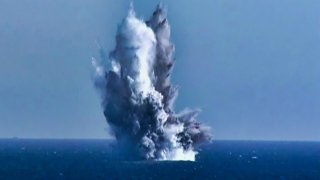Haeil-5-23 Nuclear Bomb Drone: North Korea's 'Sneak Attack' Weapon
North Korea recently tested its Haeil-5-23 nuclear-capable unmanned underwater attack weapon in response to major joint drills by the United States, Japan and South Korea, the Korean Central News Agency (KCNA) said on Friday.
A True Terror From the Deep – North Korea's Haeil-5-23 Underwater Nuke - Even as North Korea continues to struggle with the development of long-range missiles, it has made progress with another potentially devastating weapon. The Hermit Kingdom recently tested its Haeil-5-23 nuclear-capable unmanned underwater attack weapon in response to major joint drills by the United States, Japan and South Korea, the Korean Central News Agency (KCNA) said on Friday.
Pyongyang first acknowledged the existence of the weapon last March – when it announced it had tested a nuclear-capable robotic submersible, which can cause a "super-powerful radioactive tsunami" when exploding.
A test of the weapon was reported to have been conducted earlier this month in response to a joint exercise involving warships from the United States, Japan and South Korea.
"Joint maritime exercises were staged again in the waters off Jeju Island for three days from Jan. 15 with the involvement of the US nuclear carrier Carl Vinson and Aegis cruiser Princeton and warships of the Japanese Maritime Self-Defense Force and the ROK [South Korean] Navy," KCNA said. "In response to it, the Underwater Weapon System Institute under the DPRK Academy of Defence Science conducted an important test of its underwater nuclear weapon system 'Haeil-5-23' under development in the East Sea [Sea of Japan] of Korea."
"Our army's underwater nuke-based countering posture is being further rounded off and its various maritime and underwater responsive actions will continue to deter the hostile military manoeuvres of the navies of the U.S. and its allies," the North Korean ministry spokesman said in a statement, according to KCNA, as reported by Reuters.
Joint Exercises for U.S. and South Korea
The United States Navy announced that Carrier Strike Group (CSG) 1, led by its flagship, the Nimitz-class aircraft carrier USS Carl Vinson (CVN-70), Japan Maritime Self-Defense Force (JMSDF) and Republic of Korea Navy (ROKN), conducted a trilateral maritime exercise, demonstrating their commitment to bolstering regional security and stability in the Indo-Pacific, Jan. 16.
During the three-day event, the three maritime forces sailed together, conducted advanced maritime communication operations, maritime interdiction operations training, air combat drills, staff exchanges and integration, the U.S. Navy further stated, acknowledging that the allied forces last trained together in Nov. 2023.
"Our strike group welcomes the opportunity to train again and further build on our capabilities as a combined force with maritime forces from Japan and the Republic of Korea," said Rear Adm. Carlos Sardiello, CSG-1 commander. "Sailing and flying together safely alongside our allies demonstrates our commitment to improving information sharing and working together effectively, to enhance our ability to coordinate on maritime domain awareness and other shared security interests."
This year marks the 71st anniversary of the U.S.-Republic of Korea Mutual Defense Treaty of 1953, and over 70 years of partnership with Japan since the 1951 Security Treaty between the U.S. and Japan.
North Korea's "Sneak Attack" Weapon
The nuclear-capable drone – dubbed "Haeil" or "tsunami" – was first reportedly tested in March 2023, and North Korean state media said it was developed to make sneak attacks in enemy waters and destroy naval strike groups and major operational ports by creating a large radioactive wave through an underwater explosion.
However, military analysts have suggested that if the weapons function as presented by North Korea, they would be seen as a less significant weapon than the regime's nuclear ballistic missiles, the BBC reported.
"Considering North Korea's defence science level and the fact that the weapon is still in a developing stage, it is not yet at a stage to pose a significant threat," Ahn Chan-il, a defector-turned-researcher at the World Institute for North Korea Studies, also told the news agency AFP.
Russia has also developed a nuclear-armed torpedo, known as Poseidon, which was designed to strike a coastal city or naval facility. The Bulletin of the Atomic Scientists reported that the first set of the very long-range, nuclear-armed torpedoes had been produced as of early 2023.
Author Experience and Expertise: Peter Suciu
Peter Suciu is a Michigan-based writer. He has contributed to more than four dozen magazines, newspapers, and websites with over 3,200 published pieces over a twenty-year career in journalism. He regularly writes about military hardware, firearms history, cybersecurity, politics, and international affairs. Peter is also a Contributing Writer for Forbes and Clearance Jobs. You can follow him on Twitter: @PeterSuciu. You can email the author: [email protected].


